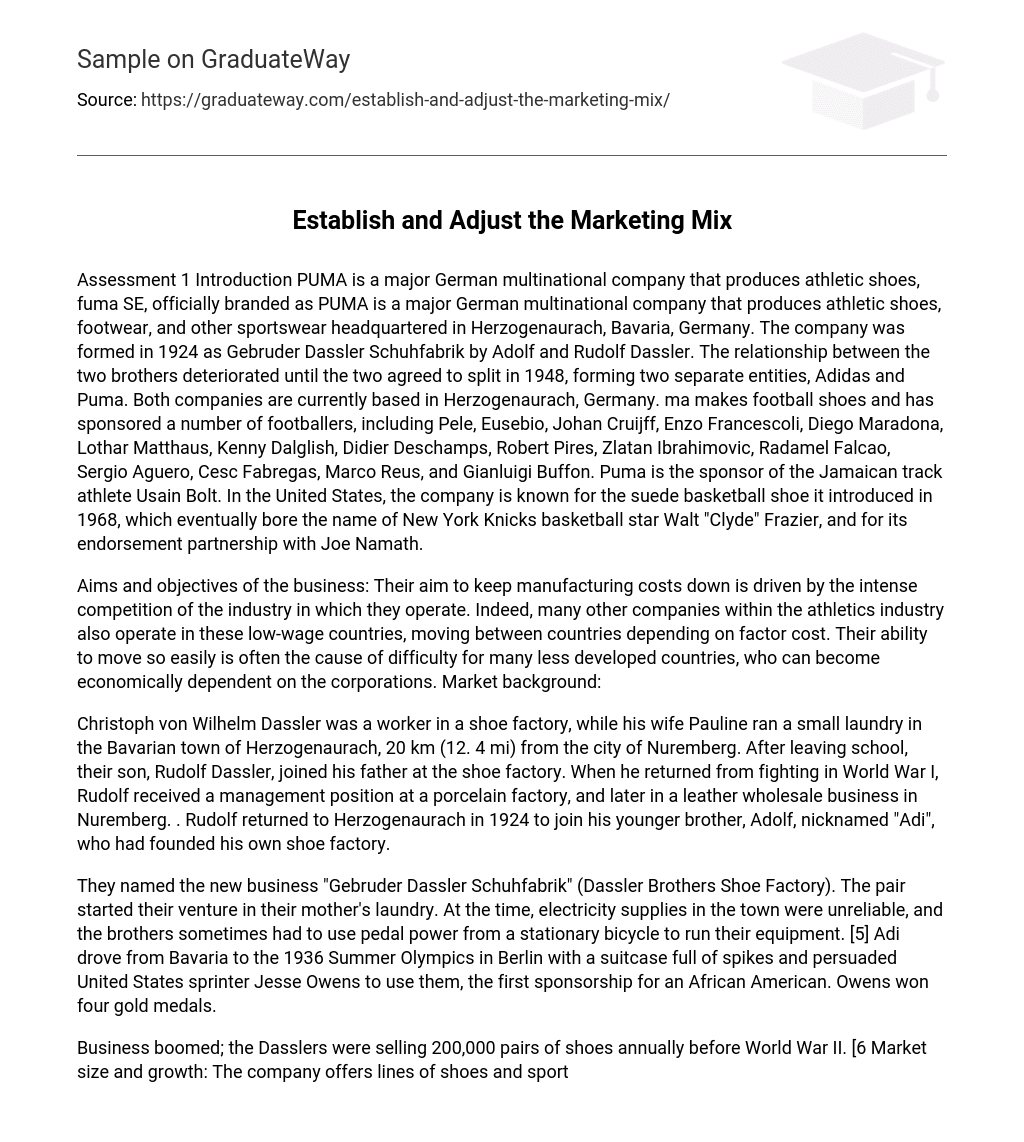Introduction
PUMA is a major German multinational company that produces athletic shoes, fuma SE, officially branded as PUMA is a major German multinational company that produces athletic shoes, footwear, and other sportswear headquartered in Herzogenaurach, Bavaria, Germany. The company was formed in 1924 as Gebruder Dassler Schuhfabrik by Adolf and Rudolf Dassler.
The relationship between the two brothers deteriorated until the two agreed to split in 1948, forming two separate entities, Adidas and Puma. Both companies are currently based in Herzogenaurach, Germany. ma makes football shoes and has sponsored a number of footballers, including Pele, Eusebio, Johan Cruijff, Enzo Francescoli, Diego Maradona, Lothar Matthaus, Kenny Dalglish, Didier Deschamps, Robert Pires, Zlatan Ibrahimovic, Radamel Falcao, Sergio Aguero, Cesc Fabregas, Marco Reus, and Gianluigi Buffon.
Puma is the sponsor of the Jamaican track athlete Usain Bolt. In the United States, the company is known for the suede basketball shoe it introduced in 1968, which eventually bore the name of New York Knicks basketball star Walt “Clyde” Frazier, and for its endorsement partnership with Joe Namath.
Aims and objectives of the business
Their aim to keep manufacturing costs down is driven by the intense competition of the industry in which they operate. Indeed, many other companies within the athletics industry also operate in these low-wage countries, moving between countries depending on factor cost. Their ability to move so easily is often the cause of difficulty for many less developed countries, who can become economically dependent on the corporations.
Market background
Christoph von Wilhelm Dassler was a worker in a shoe factory, while his wife Pauline ran a small laundry in the Bavarian town of Herzogenaurach, 20 km (12. 4 mi) from the city of Nuremberg. After leaving school, their son, Rudolf Dassler, joined his father at the shoe factory. When he returned from fighting in World War I, Rudolf received a management position at a porcelain factory, and later in a leather wholesale business in Nuremberg. . Rudolf returned to Herzogenaurach in 1924 to join his younger brother, Adolf, nicknamed “Adi”, who had founded his own shoe factory.
They named the new business “Gebruder Dassler Schuhfabrik” (Dassler Brothers Shoe Factory). The pair started their venture in their mother’s laundry. At the time, electricity supplies in the town were unreliable, and the brothers sometimes had to use pedal power from a stationary bicycle to run their equipment.
Market size and growth
The company offers lines of shoes and sports clothing designed by Lamine Kouyate, Amy Garbers, and others. Since 1996 Puma has intensified its activities in the United States. Puma owns 25% of American brand sports clothing maker Logo Athletic, which is licensed by American professional basketball and association football leagues. Since 2007 Puma SE has been part of the French luxury group PPR. ma SE has 9,500 employees and distributes its products in more than 120 countries.
For the fiscal year 2003, the company had revenue of €1. 274 billion. Puma were the commercial sponsors for the 2002 anime series Hungry Heart: Wild Striker, with the jerseys and clothing sporting the Puma brand. Puma ranks as one of the top shoe brands, after Reebok, Adidas, and Nike.
Target Market
February 2007 Puma reported that its profits had fallen by 26% to €32. 8 million ($43 million; 22 million) during the final three months of 2006. Most of the decline in profits was due to higher costs linked to its expansion; sales rose by more than a third to €480. 6 million. In early April 2007 Puma’s shares rose €29. 25 per share, or about 10. 2%, at €315. 24 per share.
On 10 April 2007 French retailer and owner of Gucci brand Pinault-Printemps-Redoute (PPR) announced that it had bought a 27% stake in Puma, clearing the way for a full takeover. The deal values Puma at €5. 3 billion. PPR said that it would launch a “friendly” takeover for Puma, worth €330 a share, once the acquisition of the smaller stake was completed.
The board of Puma welcomed the move, saying it was fair and in the firm’s best interests. Since 17 July 2007 PPR owns 62. 1% of Puma stock. While PPR owns the majority of Puma’s stock, Puma remains an independent company. In July 2011 the company completed a conversion from an Aktiengesellschaft (German public limited company) to a Societas Europaea, the European Union-wide equivalent, changing its name from Puma AG Rudolf Dassler Sport to Puma SE. At the same time, Franz Koch replaced the long-serving Jochen Zeitz as the firm’s CEO, with Zeitz becoming chairman.
Identify and evaluate new marketing opportunity Puma is a sponsor of sporting events and identities in Germany and internationally. The company sponsors numerous footballers and national football teams; the “Formstripe” especially has a heavy presence in Africa. Puma is the sponsor of a number of Bundesliga clubs, most notably Borussia Dortmund and VfB Stuttgart. In Scotland, Hibernian FC kits are made by Puma. In Australian Rules Football, Puma has long-standing marketing relationships with the Adelaide Crows and West Coast Eagles.
In cricket, Puma is the official apparel sponsor for the Sunrisers Hyderabad (representing the city of Hyderabad), and Rajasthan Royals (representing the city of Jaipur) in the Indian Premier League.





